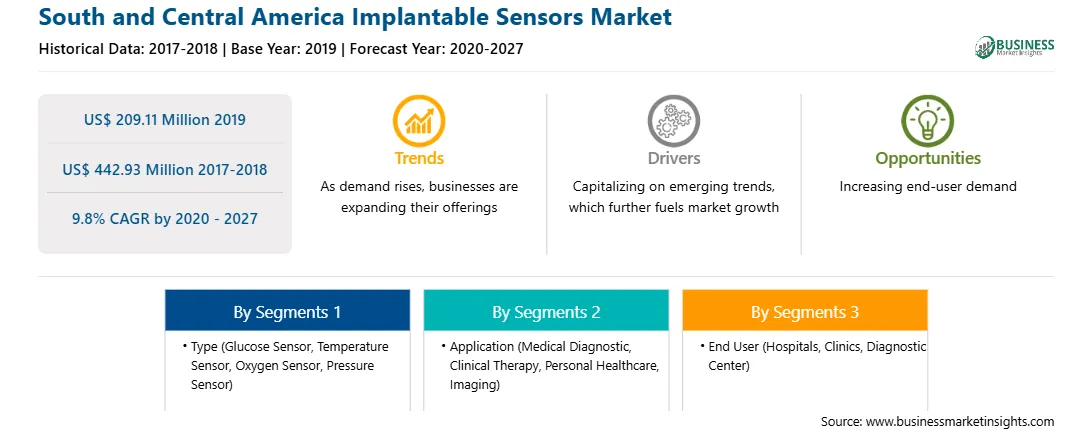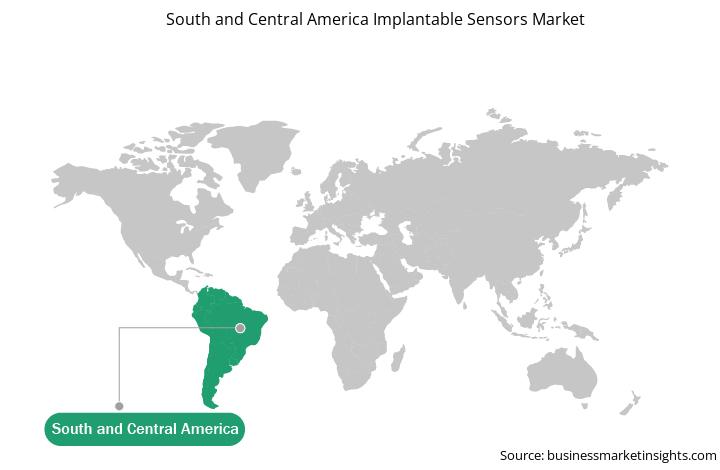Implantable sensors enable self-monitoring systems in which the patient acts as a part of the sensing system to detect changes, consciously or unconsciously, of the health conditions. Implantable sensors have been used in medical research for measuring parameters such as force, torque, pressure, and temperature inside the human body. These advanced sensor systems must be small in size, compatible with human tissue, and sturdy enough to withstand the human body's physical forces. They must also be self-powered and able to transmit data wirelessly. Ideal sensor systems are robust and straightforward, which minimizes the possibility of malfunction or failure.

Strategic insights for the South and Central America Implantable Sensors provides data-driven analysis of the industry landscape, including current trends, key players, and regional nuances. These insights offer actionable recommendations, enabling readers to differentiate themselves from competitors by identifying untapped segments or developing unique value propositions. Leveraging data analytics, these insights help industry players anticipate the market shifts, whether investors, manufacturers, or other stakeholders. A future-oriented perspective is essential, helping stakeholders anticipate market shifts and position themselves for long-term success in this dynamic region. Ultimately, effective strategic insights empower readers to make informed decisions that drive profitability and achieve their business objectives within the market.

| Report Attribute | Details |
|---|---|
| Market size in 2019 | US$ 209.11 Million |
| Market Size by 2027 | US$ 442.93 Million |
| Global CAGR (2020 - 2027) | 9.8% |
| Historical Data | 2017-2018 |
| Forecast period | 2020-2027 |
| Segments Covered |
By Type
|
| Regions and Countries Covered | South and Central America
|
| Market leaders and key company profiles |
The geographic scope of the South and Central America Implantable Sensors refers to the specific areas in which a business operates and competes. Understanding local distinctions, such as diverse consumer preferences (e.g., demand for specific plug types or battery backup durations), varying economic conditions, and regulatory environments, is crucial for tailoring strategies to specific markets. Businesses can expand their reach by identifying underserved areas or adapting their offerings to meet local demands. A clear market focus allows for more effective resource allocation, targeted marketing campaigns, and better positioning against local competitors, ultimately driving growth in those targeted areas.

The South and Central America implantable sensors market is expected to reach US$ 442.93million in 2027 from US$ 209.11million in 2019. The market is estimated to grow with a CAGR of 9.8% from 2020-2027. The growth of this market is estimated to grow owing to key driving factors such as the growing prevalence of chronic diseases across the South and Central America and a high rise in government initiatives and research & development activities to boost the healthcare sector. However, the market growth is likely to be hindered owing to the various issues related to implantable sensors.
Based on type, the implantable sensors market is segmented into glucose sensor, temperature sensor, oxygen sensor, pressure sensor, and others. Based on application, the implantable sensors market is segmented into medical diagnostic, clinical therapy, personal healthcare, and imaging. Based on end-user, the implantable sensors market, is segmented into hospitals, clinics, and diagnostic center.
Some of the major primary and secondary sources for implantable sensors market included in the report are World Health Organization (WHO), International Diabetes Federation (IDF) [South and Central America], and others.
By Type
By Country
The South and Central America Implantable Sensors Market is valued at US$ 209.11 Million in 2019, it is projected to reach US$ 442.93 Million by 2027.
As per our report South and Central America Implantable Sensors Market, the market size is valued at US$ 209.11 Million in 2019, projecting it to reach US$ 442.93 Million by 2027. This translates to a CAGR of approximately 9.8% during the forecast period.
The South and Central America Implantable Sensors Market report typically cover these key segments-
The historic period, base year, and forecast period can vary slightly depending on the specific market research report. However, for the South and Central America Implantable Sensors Market report:
The South and Central America Implantable Sensors Market is populated by several key players, each contributing to its growth and innovation. Some of the major players include:
The South and Central America Implantable Sensors Market report is valuable for diverse stakeholders, including:
Essentially, anyone involved in or considering involvement in the South and Central America Implantable Sensors Market value chain can benefit from the information contained in a comprehensive market report.